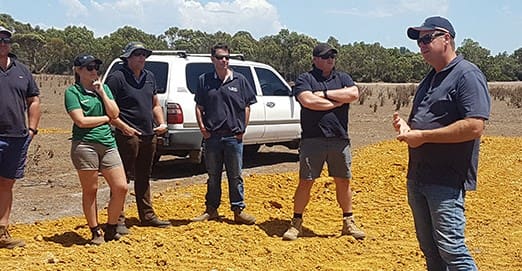
Western Australia grower, Scott Smith, talks about his claying operation, which lessens the risk of wind erosion, to members of the Esperance and Albany Regional Cropping Solutions Network in February 2020. (Photo: Julianne Hill)
EROSION and crop damage caused by severe wind can be stressful and overwhelming, and the associated decision-making is difficult, but with the passage of time and the enactment of plans to remedy losses, you get through it.
This is the experience of South Stirling grower Scott Smith following winds on May 25 that significantly impacted northern areas of Western Australia’s grainbelt.
In 2018, he experienced similarly devastating winds on his farm 80 kilometres north-east of Albany, in the state’s southern cropping area.
“I think the key is to minimise your losses and to have another crack the next year – to stabilise everything as quickly as you can and to tidy up as much as you can,” Mr Smith said.
“While it can feel like there is no right or wrong answers, getting out there and doing the best you can is helpful.
“The hardest thing was making a call, one way or the other, to either look after what was left of the crops, or to reseed them. But making a decision relieved the pressure and allowed us to focus on what we thought needed to be done.”
The event last month in the northern grainbelt saw winds of more than 80 kilometres per hour sustained over about eight hours, causing significant erosion and crop damage, and forcing growers to make difficult decisions on reseeding crops at a late stage in the sowing window.
Wind damage was exacerbated by the fact there was minimal stubble cover on paddocks – a legacy of dry conditions in 2019 and rain in early autumn. The scale of impact was significant and widespread, and not restricted to paddocks that had recently been spaded or deep ripped.
Previous experience
Mr Smith, who is also a member of the GRDC’s Albany port zone Regional Cropping Solutions Network (being renamed the GRDC Grower Network) said in May 2018 he experienced a similar situation after extremely strong winds of up to 120km/hr swept across his South Stirling farm.
The event came after two consecutive extremely wet and poor years (very wet seasons are often poor cropping years for the Smiths) that left bare areas in paddocks and stubble loosened from the ground.
“Any canola crops that had germinated prior to May 24 that year were gone, and most of the district subsequently reseeded probably half their programs,” he said.
“Then came another two ‘big blows’ which finished off cereal crops that were starting to recover, and cereal crops also then had to be reseeded.”
Crop assessment
Mr Smith said that, with assistance from his agronomist, he assessed plant numbers per square metre and worked out the yield potential.
“Some canola crops were written off and, depending on herbicides that had been applied to paddocks, we switched as many paddocks as we could to cereals, especially barley, given canola takes a lot longer to cover the ground and is more prone to being cut off again,” he said.
“We were seeding winter crops until the end of July, to get cover on these paddocks and to get some return from the season, and then seeding summer crops for grazing in October.
“It does improve your attitude when you run a seeder through a paddock that has blown, and it starts to look like a paddock again.
“There were a lot of stories of very late planted crops, with minimal inputs, still making some money in our district, although I realise the situation in the northern grainbelt is different with generally hot springs.”
Other longer-term issues were ‘incredibly rough’ paddocks with soil blown into lumps.
There were also unanticipated issues such as shed gutters being ‘chock-a-block full’ of sand.
“Cleaning gutters and dirt off the sides of sheds and fencelines, and picking up fallen-over trees and silos, are not immediate priorities after the winds, but it does provide a psychological boost to bring back some normality on the farm.
“Talking to others in the community, and realising everyone’s got the same issues, is also helpful.”
Ground cover
Mr Smith said that, since 2018, his family had made a conscious decision not to dry seed crops into paddocks that did not have sufficient cover.
“We are also looking at changing some of our rotations,” he said.
“Currently we plant canola into pasture paddocks, but that rotation is the most prone to blowing, and we are considering the viability of planting cereals into pasture, and then following with canola.”
Mr Smith said growers in his district with the capacity to do so were spreading clay on very sandy paddocks, which lessened the risk of wind erosion.
Source: GRDC
Mr Smith offered his insights as part of a recent online panel organised by the Grains Research and Development Corporation (GRDC) to discuss crop considerations following the wind damage.
A recording is available on the GRDC’s YouTube channel at https://bit.ly/3cq9rC8.
Other panellists included Department of Primary Industries and Regional Development (DPIRD) wheat agronomy researcher Dion Nicol, Geraldton-based DPIRD soils researcher Wayne Parker and Agrarian Management consultant Craig Topham.
In addition to grower insights, other areas covered in the GRDC webinar included considerations for cereal, lupin and canola crops following wind damage, evaluating reseeding options and herbicide issues; longer-term soil amelioration considerations; and relevant GRDC investments.
Information about reseeding canola is available on page 39 of the ‘Canola agronomy research in WA bulletin’, available at https://bit.ly/36JodCD, and on the DPIRD website at bit.ly/2ZNpA1C.
The GRDC publication ‘Rotational crop constraints for herbicides used in Australian farming systems’, available at https://bit.ly/3eW27Qr, contains information about the soil persistence of herbicides and their potential impact on subsequent crops.

HAVE YOUR SAY